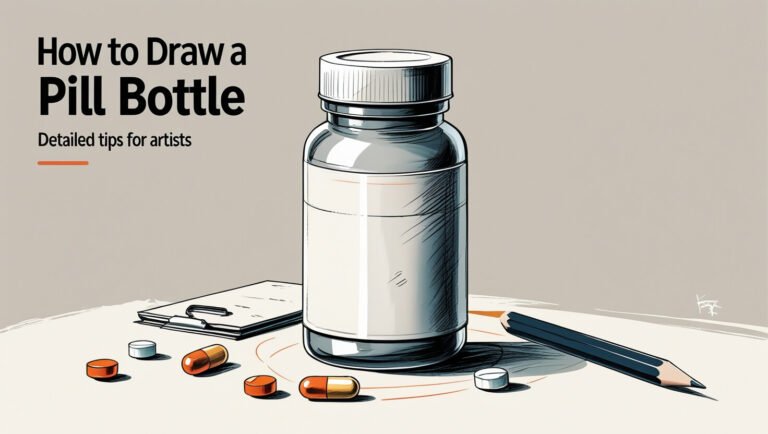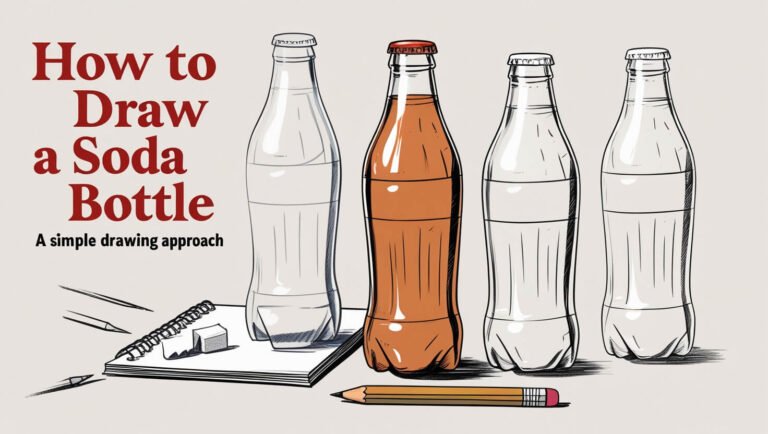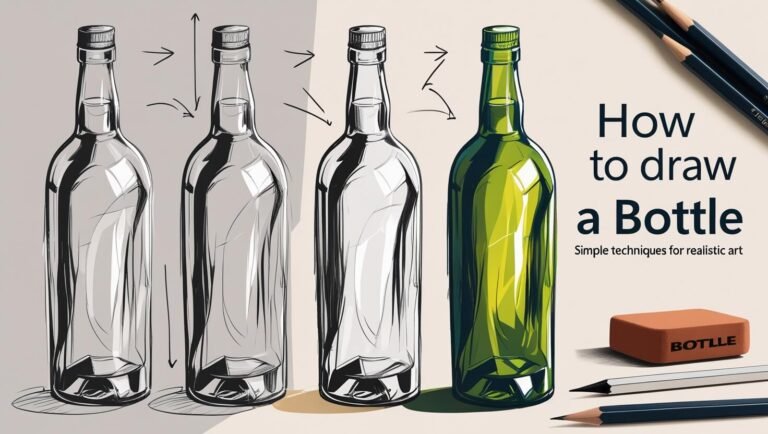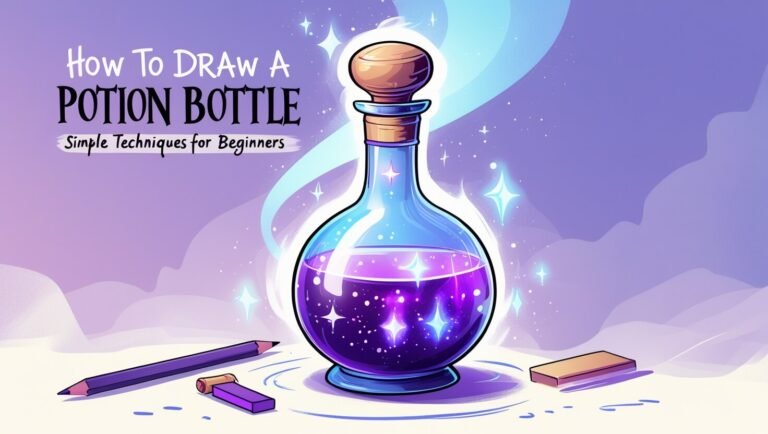How To Draw A Prime Bottle: Techniques for a Realistic Sketch
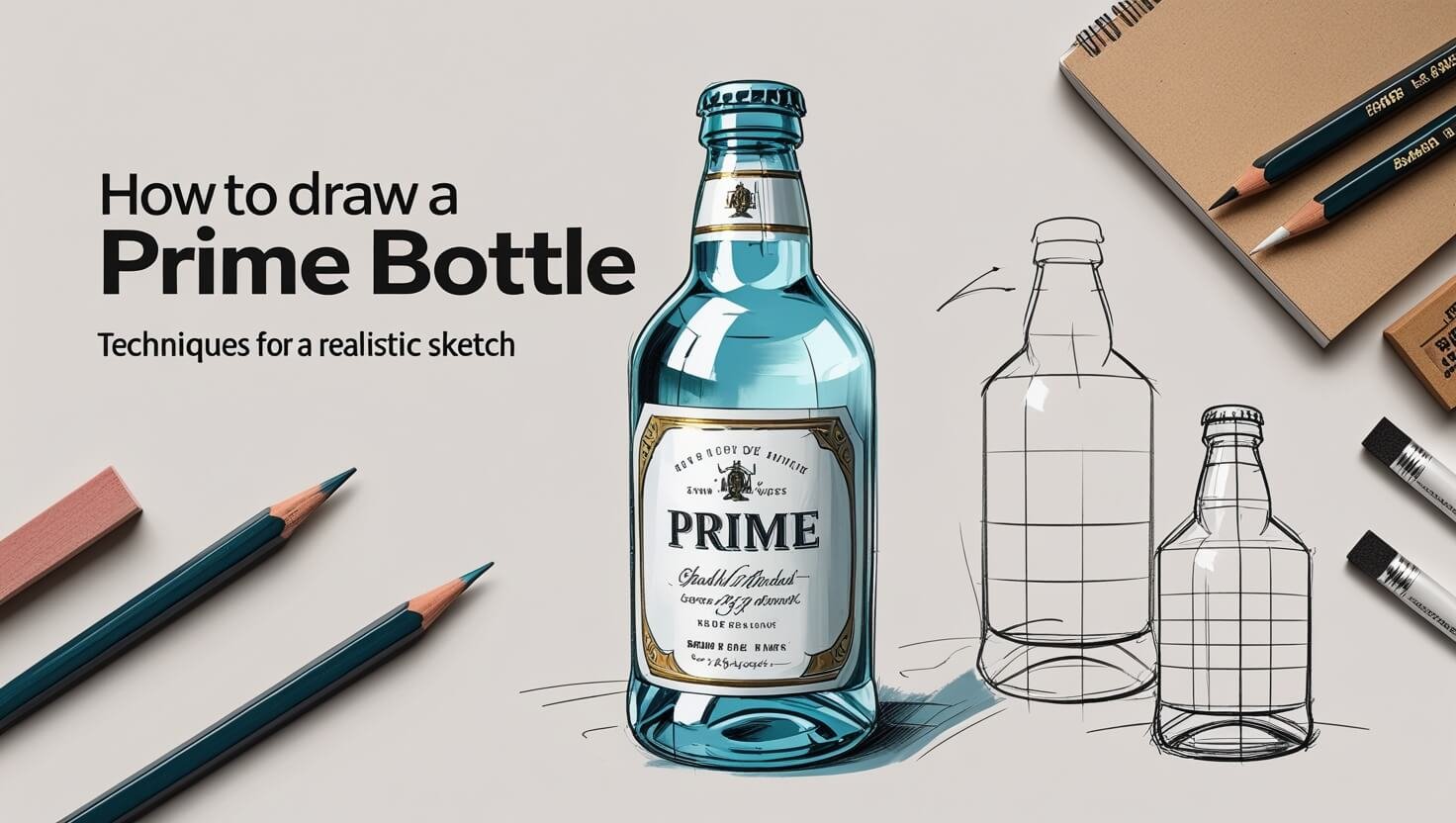
What makes a bottle drawing truly captivating? Is it the detailed work or the way it seems to leap off the page? Learning to draw a prime bottle is both fun and rewarding. With a step-by-step guide, you can make stunning illustrations that show the true nature of this common object.
In this tutorial, we’ll cover the techniques and skills needed to bring your bottle drawings to life. We’ll give you the knowledge to create beautiful, realistic artwork. Whether you’re an experienced artist or just starting, learning to draw a prime bottle can improve your skills and challenge your creativity.
With the right techniques and tools, you can make beautiful, detailed drawings. These will showcase your artistic talents. So, let’s start this journey to create a prime bottle drawing. We’ll share the tips and tricks you need to succeed with a detailed prime bottle drawing tutorial.
Essential Art Supplies for Prime Bottle Drawing
To create stunning prime bottle drawings, you need the right art supplies. The quality of materials is key, as prime bottle sketching tips show. For beginners, a few essential tools can boost their prime bottle drawing for beginners skills.
Choosing the right paper is a good start. Arches Cold Press Paper is a favorite among artists, great for layers of wet media. For quick studies, Canson Mixed Media Imagine Paper is a budget-friendly choice. The right paper is important for prime bottle illustration techniques, affecting texture and effect.
Paper Selection and Surface Textures
Knowing the different papers and their textures is key for prime bottle drawing. Here’s a table of popular paper options:
| Paper Type | Texture | Weight |
|---|---|---|
| Arches Cold Press Paper | Rough | 300 gsm |
| Canson Mixed Media Imagine Paper | Smooth | 200 gsm |
Pencil Types and Grades
Having the right pencils is also vital for prime bottle drawing. Derwent Inktense Pencils and Faber-castell Polychromos Pencils are top picks. They offer a variety of grades and colors for different techniques.
By investing in these essential art supplies and learning prime bottle sketching tips, artists can improve their prime bottle drawings. They can achieve stunning results.
Basic Bottle Shapes and Forms
The prime bottle drawing process starts with knowing the basic shapes of bottles. It’s key to break down the bottle into its main parts: the body, neck, and base. This makes your drawing more accurate and lifelike.
In an easy prime bottle drawing tutorial, you’ll begin by sketching the bottle’s shape. You’ll focus on its size and proportions. This is the base of your drawing, where you can add details and shape it further.
There are several common bottle shapes and forms. These include:
- Cylindrical bottles with straight sides and a flat base
- Tapered bottles with a narrower neck and a rounded base
- Spherical bottles with a rounded body and a short neck
Learning these basic shapes lets you draw many types of bottles. You can go from simple scenes to detailed ones. Always aim to create depth and space in your drawings. And don’t hesitate to try new things and practice to get better.
| Bottle Shape | Description |
|---|---|
| Cylindrical | Straight sides and flat base |
| Tapered | Narrower neck and rounded base |
| Spherical | Rounded body and short neck |
Light Sources and Shadow Placement
When making a prime bottle art tutorial, knowing about light and shadow is key. Light and shadow make 2D art look real by showing form and space. For a prime bottle drawing for beginners, learning to use light sources is vital.
First, think about the light sources: natural and artificial. Natural light from windows makes soft shadows. Artificial light lets you control the light’s direction and strength. Here are some tips for using light and shadow:
- Natural Light Techniques: Watch how natural light falls on your subject, making soft shadows and highlights.
- Artificial Light Effects: Try different artificial light sources, like lamps or overhead lights, for various effects.
- Shadow Mapping Methods: Use different values, from light to dark, to map shadows on your subject.
Mastering these methods will add depth and realism to your prime bottle art tutorial and prime bottle drawing for beginners. Remember, the more you practice, the better you’ll get. So, don’t hesitate to try new things.
| Light Source | Shadow Effect |
|---|---|
| Natural Light | Soft Shadows |
| Artificial Light | Harsh Shadows |
How to Draw a Prime Bottle: Core Steps
To make a beautiful bottle drawing, you need to know the basic steps. A prime bottle drawing tutorial starts with simple shapes. These include vertical lines for the height and curved lines for the bottom and top.
When you learn how to draw a prime bottle, you’ll need some tools. These are a pencil, paper, eraser, and coloring supplies. Drawing a bottle can take about 30 minutes with practice.
Here are the main steps to follow:
- Start by drawing vertical lines to define the height of the bottle
- Add a curved bottom line and smooth rounded lines for the bottle top
- Refine your drawing by adding details, such as a label and texture
- Experiment with different drawing techniques, including shading and coloring
A prime bottle drawing tutorial can boost your art skills. It helps you make a stunning bottle illustration. Always practice and enjoy the journey of learning how to draw a prime bottle.
| Materials | Time Needed | Drawing Steps |
|---|---|---|
| Pencil, paper, eraser, coloring supplies | 30 minutes | Vertical lines, curved bottom line, smooth rounded lines |
Texture and Surface Details
Creating a realistic prime bottle illustration requires focus on texture and surface details. Prime bottle drawing for beginners can be tough, but with the right methods, anyone can get great results. First, it’s key to know the different textures used in prime bottle illustrations.
Textures like glass, label, and surface reflections are common. Glass effects and transparency can be achieved through layering and blending. Label design adds realism, while surface reflection methods create depth and dimension.
Techniques for Texture and Surface Details
- Layering: This technique involves layering different textures and colors to create a realistic effect.
- Blending: Blending colors and textures can help create a smooth, realistic surface.
- Stamping: Stamping textures and patterns can add an extra layer of interest to the illustration.
Using these techniques in your prime bottle drawing can lead to a realistic and detailed illustration. Whether you’re new or experienced, practicing these techniques can enhance your skills and create amazing art.
| Technique | Description |
|---|---|
| Layering | Layering different textures and colors to create a realistic effect. |
| Blending | Blending colors and textures to create a smooth, realistic surface. |
| Stamping | Stamping textures and patterns to add an extra layer of interest to the illustration. |
Perspective and Proportion Rules
Understanding perspective and proportion is key in the prime bottle drawing process. A good drawing makes objects look real in 2D art. Artists use techniques like one-point and two-point perspective to get this right. In an easy prime bottle drawing tutorial, you’ll learn these tricks for realistic drawings.
Contour lines are important for defining the bottle’s shape and size. The tutorial on translucent bottles uses a Three Tonality System for contrast and space. This method involves light to dark values to add depth to the bottle.
Here are some tips for mastering perspective and proportion in bottle drawing:
- Use reference photos for accurate bottle shape and size
- Apply one-point and two-point perspective for depth and space
- Focus on contour lines and edges to define the bottle’s shape
Follow these tips and practice the prime bottle drawing process to make realistic bottle drawings. Always keep proportions right and perspective consistent. Don’t hesitate to try different techniques and styles. With an easy prime bottle drawing tutorial, you’ll soon create amazing bottle drawings.
Shading Methods for Bottle Art
Shading methods are key in a prime bottle art tutorial. They bring the artwork to life. For beginners, knowing different shading techniques is vital for realistic and captivating results.
Artists use various shading methods to add depth and dimension. Techniques like cross-hatching, blending, and tonal variations are common. They help create everything from subtle shading to bold contrasts.
Here are some key shading methods for beginners:
- Cross–hatching: This technique involves layering lines at different angles to create a range of values and textures.
- Blending: This method involves merging colors together to create smooth, gradual transitions between shades.
- Tonal variations: This technique involves using different values of a single color to create a sense of depth and dimension.
Practicing shading methods improves skills and helps create stunning prime bottle art with professional results, even for beginners.
| Shading Method | Description |
|---|---|
| Cross-hatching | Layering lines at different angles to create a range of values and textures |
| Blending | Merging colors together to create smooth, gradual transitions between shades |
| Tonal variations | Using different values of a single color to create a sense of depth and dimension |
Advanced Reflection Techniques
Creating realistic reflections in prime bottle illustration techniques is key. Artists must know the surface type they’re drawing. Glass and metal need different methods for a believable reflection. Beginners in prime bottle drawing should grasp the basics of reflection and apply them to various surfaces.
To make a realistic reflection, artists use several techniques. They observe how light interacts with surfaces. They also try different media, like watercolor or ink washes. And they practice styles, such as collaging or altering sketchbook pages.
- Observing the way light interacts with different surfaces
- Experimenting with various media, such as watercolor or ink washes
- Practicing different styles, such as collaging or altering sketchbook pages creatively
Mastering prime bottle illustration techniques and realistic reflections adds depth to art. Whether it’s a simple drawing or a complex scene, prime bottle drawing for beginners is essential. As artists improve, their work becomes more engaging and realistic. This shows their skill and creativity.
Background Elements and Composition
Background elements and composition are key in the prime bottle drawing process. They make the art visually appealing. An easy prime bottle drawing tutorial should teach how to use background elements well. Edgar Payne’s book “Composition of Outdoor Painting” talks about 15 compositional archetypes for art, including prime bottle drawings.
Composition involves where you place the prime bottle. It can sit on a table or be part of a complex scene. The aim is to add depth and dimension to the drawing. Some artists prefer simple backgrounds, while others like detailed ones.
Environmental Integration
Environmental integration is vital in background elements and composition. It means fitting the prime bottle into its surroundings. This includes lighting, textures, and other visual elements. For instance, a tutorial might suggest placing the bottle near a window for natural light.
Techniques for background elements and composition include:
- Using a limited color palette for cohesion and harmony
- Adding textures and patterns for depth and interest
- Trying different lighting effects for mood and atmosphere
Artists can create engaging compositions that draw attention to the subject.
Common Mistakes and Solutions
When you’re doing a prime bottle art tutorial, knowing common mistakes is key. Beginners often struggle with getting the bottle’s size and shape right. To fix this, measure and sketch the bottle’s dimensions carefully. This ensures your drawing looks accurate.
Another issue is not adding enough shading and texture. This makes your drawing look flat. To solve this, try different shading methods like cross-hatching and blending. Also, don’t forget to include details like labels and reflections to make your drawing look real.
- Incorrect proportion and perspective
- Inadequate shading and texture
- Poor attention to surface details
By knowing and fixing these mistakes, artists can get better at drawing bottles. Remember, the more you practice, the better you’ll get. With hard work and attention to detail, beginners can make amazing bottle drawings.
| Mistake | Solution |
|---|---|
| Incorrect proportion and perspective | Carefully measure and sketch the bottle’s dimensions |
| Inadequate shading and texture | Practice various shading techniques, such as cross-hatching and blending |
| Poor attention to surface details | PAY attention to labels, reflections, and other surface details |
Final Touches and Refinements
To make a prime bottle illustration stand out, focus on the final details. Prime bottle illustration techniques help add depth and dimension. For beginners, understanding detail enhancement and professional finishing is key.
Some important techniques for the final touches include:
- Adding subtle shading and texture to the bottle
- Enhancing the label and cap details
- Creating a sense of depth and dimension with layering and blending
- Using prime bottle illustration techniques to add realistic reflections and highlights
By using these techniques in your prime bottle drawing for beginners, your work will look polished and professional. Take your time and focus on the small details. They can greatly improve your illustration’s quality.
| Technique | Description |
|---|---|
| Layering | Creating a sense of depth by layering different elements of the illustration |
| Blending | Merging colors and textures to create a smooth and realistic effect |
| Shading | Adding dimension and depth to the illustration by using different shading techniques |
With practice and patience, you’ll get better at these prime bottle illustration techniques. You’ll create stunning illustrations that show off your skills and attention to detail.
Let’s Complete
As we wrap up this prime bottle drawing tutorial, remember drawing is more than copying reality. It’s about capturing the illusion of form and space on a 2D canvas. The how to draw a prime bottle techniques we’ve covered are ways to share our unique views and interpretations.
Learning to draw bottles well takes time, patience, and practice. By improving your skills in perspective, shading, and detail, you’ll make amazing bottle illustrations. These will grab the viewer’s attention and show off your talent. The key is not to be perfect but to enjoy the journey and grow.
Keep working on your bottle drawing skills and don’t be afraid to try new things. Bottle drawing is a flexible medium used in many fields, like product design and packaging. With hard work and a sharp eye, you’ll make drawings that inspire and amaze.

